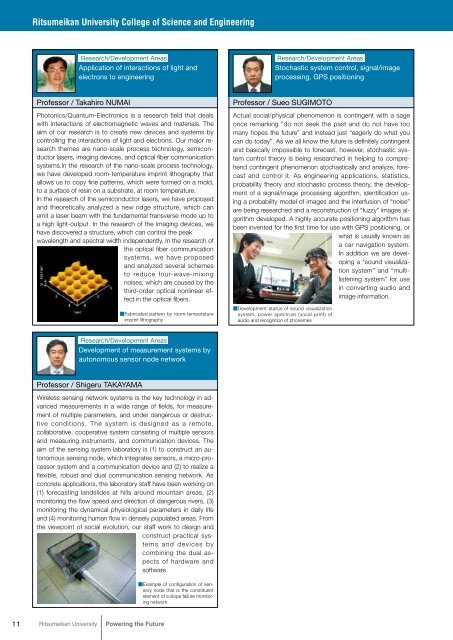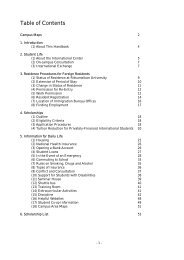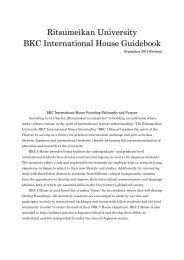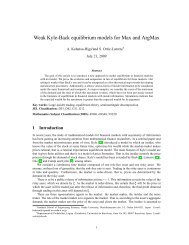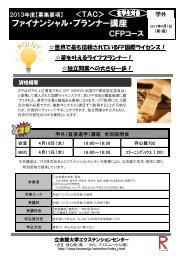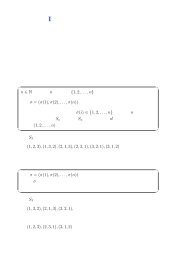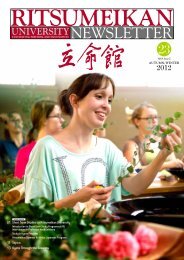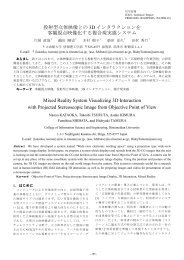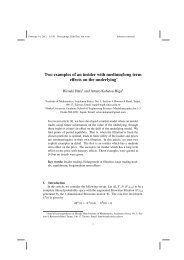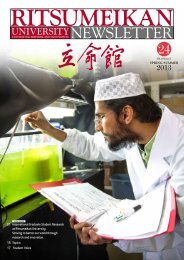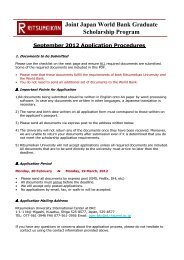Powering the Future - 立命館大学
Powering the Future - 立命館大学
Powering the Future - 立命館大学
Create successful ePaper yourself
Turn your PDF publications into a flip-book with our unique Google optimized e-Paper software.
Ritsumeikan University College of Science and Engineering<br />
Research/Development Areas<br />
Application of interactions of light and<br />
electrons to engineering<br />
Research/Development Areas<br />
Stochastic system control, signal/image<br />
processing, GPS positioning<br />
Professor / Takahiro NUMAI<br />
Photonics/Quantum-Electronics is a research field that deals<br />
with interactions of electromagnetic waves and materials. The<br />
aim of our research is to create new devices and systems by<br />
controlling <strong>the</strong> interactions of light and electrons. Our major research<br />
<strong>the</strong>mes are nano-scale process technology, semiconductor<br />
lasers, imaging devices, and optical fiber communication<br />
systems.In <strong>the</strong> research of <strong>the</strong> nano-scale process technology,<br />
we have developed room-temperature imprint lithography that<br />
allows us to copy fine patterns, which were formed on a mold,<br />
to a surface of resin on a substrate, at room temperature.<br />
In <strong>the</strong> research of <strong>the</strong> semiconductor lasers, we have proposed<br />
and <strong>the</strong>oretically analyzed a new ridge structure, which can<br />
emit a laser beam with <strong>the</strong> fundamental transverse mode up to<br />
a high light-output. In <strong>the</strong> research of <strong>the</strong> imaging devices, we<br />
have discovered a structure, which can control <strong>the</strong> peak<br />
wavelength and spectral width independently. In <strong>the</strong> research of<br />
<strong>the</strong> optical fiber communication<br />
systems, we have proposed<br />
and analyzed several schemes<br />
to reduce four-wave-mixing<br />
noises, which are caused by <strong>the</strong><br />
third-order optical nonlinear effect<br />
in <strong>the</strong> optical fibers.<br />
■Fabricated pattern by room-temperature<br />
imprint lithography<br />
Professor / Sueo SUGIMOTO<br />
Actual social/physical phenomenon is contingent with a sage<br />
once remarking “do not seek <strong>the</strong> past and do not have too<br />
many hopes <strong>the</strong> future” and instead just “eagerly do what you<br />
can do today”. As we all know <strong>the</strong> future is definitely contingent<br />
and basically impossible to forecast, however, stochastic system<br />
control <strong>the</strong>ory is being researched in helping to comprehend<br />
contingent phenomenon stochastically and analyze, forecast<br />
and control it. As engineering applications, statistics,<br />
probability <strong>the</strong>ory and stochastic process <strong>the</strong>ory, <strong>the</strong> development<br />
of a signal/image processing algorithm, identification using<br />
a probability model of images and <strong>the</strong> interfusion of “noise”<br />
are being researched and a reconstruction of “fuzzy” images algorithm<br />
developed. A highly accurate positioning algorithm has<br />
been invented for <strong>the</strong> first time for use with GPS positioning, or<br />
what is usually known as<br />
a car navigation system.<br />
In addition we are developing<br />
a “sound visualization<br />
system” and “multilistening<br />
system” for use<br />
in converting audio and<br />
image information.<br />
■Development status of sound visualization<br />
system, power spectrum (vocal print) of<br />
audio and recognition of phonemes<br />
Research/Development Areas<br />
Development of measurement systems by<br />
autonomous sensor node network<br />
Professor / Shigeru TAKAYAMA<br />
Wireless sensing network systems is <strong>the</strong> key technology in advanced<br />
measurements in a wide range of fields, for measurement<br />
of multiple parameters, and under dangerous or destructive<br />
conditions. The system is designed as a remote,<br />
collaborative, cooperative system consisting of multiple sensors<br />
and measuring instruments, and communication devices. The<br />
aim of <strong>the</strong> sensing system laboratory is (1) to construct an autonomous<br />
sensing node, which integrates sensors, a micro-processor<br />
system and a communication device and (2) to realize a<br />
flexible, robust and dual communication sensing network. As<br />
concrete applications, <strong>the</strong> laboratory staff have been working on<br />
(1) forecasting landslides at hills around mountain areas, (2)<br />
monitoring <strong>the</strong> flow speed and direction of dangerous rivers, (3)<br />
monitoring <strong>the</strong> dynamical physiological parameters in daily life<br />
and (4) monitoring human flow in densely populated areas. From<br />
<strong>the</strong> viewpoint of social evolution, our staff work to design and<br />
construct practical systems<br />
and devices by<br />
combining <strong>the</strong> dual aspects<br />
of hardware and<br />
software.<br />
■Example of configuration of sensory<br />
node that is <strong>the</strong> constituent<br />
element of a slope failure monitoring<br />
network<br />
11 Ritsumeikan University <strong>Powering</strong> <strong>the</strong> <strong>Future</strong>


